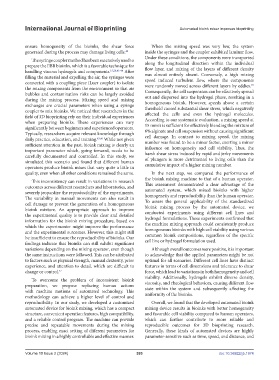Page 401 - IJB-10-2
P. 401
International Journal of Bioprinting Automated bioink mixer improves bioprinting
ensure homogeneity of the bioinks, the shear force When the mixing speed was very low, the system
generated during the process may damage living cells. 40 inside the syringes and the coupler exhibited laminar flow.
The syringe coupler method has been extensively used to Under these conditions, the components were transported
prepare the EBB bioinks, which is a favorable technique for along the longitudinal direction within the individual
handling viscous hydrogels and components. 15,20,41-44 After flow layer, and mixing of the layers of different density
filling the material and expelling the air, the syringes were was almost entirely absent. Conversely, a high mixing
connected with a coupling piece (Luer coupler) to isolate speed induced turbulent flow, where the components
48
the mixing components from the environment so that air were randomly moved across different layers by eddies.
bubbles and contamination risks can be largely avoided Consequently, the cell suspension can be effectively spread
during the mixing process. Mixing speed and mixing out and dispersed into the hydrogel phase, resulting in a
exchanges are crucial parameters when using a syringe homogeneous bioink. However, speeds above a certain
coupler to mix bioinks. We noticed that researchers in the threshold caused substantial shear stress, which negatively
field of 3D bioprinting rely on their individual experiences affected the cells and even the hydrogel molecules.
when preparing bioinks. These experiences can vary According to our systematic evaluation, a mixing speed at
significantly between beginners and experienced operators. 15 mm/s is sufficient for effectively blending the mixture of
Typically, researchers acquire relevant knowledge through 6% alginate and cell suspension without causing significant
daily practice, education, and training. 45,46 While not given cell damage. In contrast to mixing speed, the mixing
sufficient attention in the past, bioink mixing is clearly an number was found to be a minor factor, exerting a minor
important parameter which, going forward, needs to be influence on homogeneity and cell viability. Thus, the
carefully documented and controlled. In this study, we harsh shear stress induced by rapid and jerky movements
simulated this scenario and found that different human of plungers is more detrimental to living cells than the
operators produce bioink mixes that vary quite a little in cumulative impact of a higher mixing number.
quality, even when all other conditions remained the same. In the next step, we compared the performance of
the bioink mixing machine to that of a human operator.
This inconsistency can result in variations in research
outcomes across different researchers and laboratories, and This assessment demonstrated a clear advantage of the
automated system, which mixed bioinks with higher
severely jeopardize the reproducibility of the experiments. homogeneity and reproducibility than the human operator.
The variability in manual movements can also result in To assess the general applicability of the standardized
cell damage or prevent the generation of a homogeneous bioink mixing process by the automated device, we
bioink mixture. An appropriate approach to improve conducted experiments using different cell lines and
the experimental quality is to provide clear and detailed hydrogel formulations. These experiments confirmed that
information for the bioink mixing procedure, based on the machine mixing approach could consistently produce
which the experimenter might improve the performance homogeneous bioinks with high cell viability using various
and the experimental outcomes. However, this might still common bioink compositions, regardless of the specific
be insufficient to ensure the reproducibility of bioinks. Our cell line or hydrogel formulation used.
findings indicate that bioinks can still exhibit significant
variations depending on the mixing operator, even though Although overall outcomes were positive, it is important
the same instructions were followed. This can be attributed to acknowledge that the applied parameters might be not
to factors such as physical strength, manual dexterity, prior optimal for all scenarios. Different cell lines have distinct
experience, and attention to detail, which are difficult to features in terms of cell dimensions and tolerance to shear
change or control. 47 force, which lead to variations in both homogeneity and cell
To overcome the problem of inconsistent bioink viability. Additionally, hydrogels exhibit diverse density,
preparation, we propose replacing human actions viscosity, and rheological behaviors, causing different flow
with machine motions of automated technology. This state within the system and subsequently affecting the
methodology can achieve a higher level of control and uniformity of the bioinks.
reproducibility. In our study, we developed a customized Overall, we found that the developed automated bioink
automated device for bioink mixing, which has a compact mixing device results in bioinks with better homogeneity
structure, convenient operation features, high compatibility, and favorable cell viability compared to human operators,
and a reliable control program. The machine can provide which can further contribute to more reliable and
precise and repeatable movements during the mixing reproducible outcomes for 3D bioprinting research.
process, enabling exact setting of different parameters for Generally, these kinds of automated devices are highly
bioink mixing in a highly controllable and effective manner. parameter-sensitive such as time, speed, and distance, and
Volume 10 Issue 2 (2024) 393 doi: 10.36922/ijb.1974

